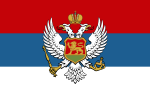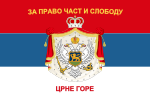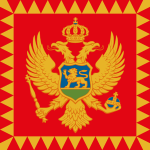List of flags of Montenegro
Appearance

This is a list of flags used in Montenegro. For more information about the national flag, visit the article Flag of Montenegro.
Wikimedia Commons has media related to Flags of Montenegro.
National flags
[edit]| Flag | Date | Use | Description |
|---|---|---|---|
 |
2004– | National flag; civil and state ensign; Naval ensign until 2010. | Red with a golden border and the state coat of arms in the middle. Ratio: 1:2. Adopted on 13 July 2004.[1] |
 |
2004– | National flag, Vertical Banner | Red with a golden border and the state coat of arms in the middle. |
Standards
[edit]Military
[edit]| Flag | Date | Use | Description |
|---|---|---|---|
 |
2010 — present | Flag of the Army of Montenegro. | Red background with the logo of the Armed Forces of Montenegro and the traditional motto "Čojstvo i Junaštvo" (roughly translated as "Humanity and Courage"), with golden borders. |
 |
2010 — present | Naval ensign of Montenegro. | Blue with the national flag in as its canton, occupying 2/5 of its width and 1/2 of its length with a white anchor interlaced with three lines representing surface of the water in the right side. |
 |
2010 — present | Naval jack of Montenegro. | Coat of Arms of Montenegro on blue background, with golden borders. |
Municipal flags
[edit]Ethnic groups flags
[edit]| Flag | Date | Use | Description |
|---|---|---|---|
 |
2008 — present | The national flag of Serbs in Montenegro. | Horizontal tricolor of red, blue and white with golden cross pattée. |
 |
2004 — present | The national flag of Bosniaks in Montenegro. | White background with the coat of arms in the middle. |

|
2020 — present | The national flag of Albanians in Montenegro.[2][3] | A red field with a black two-headed eagle in the center. |

|
2020 — present | The national flag of Croats in Montenegro.[4][3] | A horizontal tricolour of red, white, and blue with the Coat of Arms of in the centre. |

|
2020 — present | The national flag of Romani people in Montenegro.[5][3] | Horizontal bicolor of blue and green with a red wheel. |
Historical flags
[edit]National flags
[edit]| Flag | Date | Use | Description |
|---|---|---|---|
 |
1451–1496 | Flag of medieval Montenegrin state Zeta | Red flag with golden double-headed eagle |
 |
1516–1852 | Flag of the Prince-Bishopric of Montenegro | White cross pattée on red background. |
 |
1767–1773 | Flag of the Montenegro during the reign of Stephen the Little | White background with red borders. |
 |
1852–1860 | Flag of the Principality of Montenegro under Danilo I | Red flag with white double-headed eagle |
 |
1860–1905 | Flag of the Principality of Montenegro under Nicholas I | |
  |
1905–1918 | Top: State flag of the Principality (1905–10) and the Kingdom of Montenegro (1910–18)[6] Bottom: Civil flag of the Principality (1905–10) and the Kingdom of Montenegro (1910–18) |
Top: Red-blue-white tricolor with white double-headed eagle. Bottom: Red-blue-white tricolor. |
 |
1945–1993 | Flag of the People's/Socialist Republic of Montenegro | Red-blue-white tricolor with the communist red star. |
 |
1993–2004 | Flag of the Republic of Montenegro | Red-bluish-white tricolour, with "bluish" (plavetna/плаветна) meaning light-blue.[7] |
Royal flags
[edit]| Flag | Date | Use | Description |
|---|---|---|---|
 |
16th century | Stag of the House of Crnojević | Flag during regime of House of Crnojević in Principality of Zeta/ Montenegro (1451–1516). |
 |
theocratical rule of Petrović-Njegoš dynasty | Banner of the Prince-bishops of Montenegro and Metropolitans of Cetinje from House of Petrović | Orthodox red cross in a white field with a red border. Represents the highly Christian virtue of subjected peoples and the desire to fight against invading Islam. Adopted during the Great Turkish War at the end of the 17th century. |
 |
c. 1852 | Princely standard | Court flag and Princely standard during regime of Danilo II Petrović-Njegoš. |
 |
1861–1900 | Princely standard | Court flag and Princely standard during regime of Nikola I Petrović-Njegoš. |
 |
1910–1918 | Royal standard of the King of Montenegro | The lion was replaced by Nikola's cypher H.I. The crown was changed from a princely to a royal crown. |
Civil ensigns
[edit]| Flag | Date | Use | Description |
|---|---|---|---|
 |
1881-1916 | Civil ensign flag | Tricolor with the Cyrillic cypher НІ (i.e. NI) of Prince Nicholas I topped with a golden crown in the center. Because the owners as well as the crew of Montenegro's Ulcinj cruisers were Muslims, Nikola changed the flag not to offend Islam |
 |
1881–1916 | Civil ensign flag | Version of the Civil Ensign that was predominantly used. Usage extended beyond primary purpose to even of that of the National flag. |
 |
late 1880-early 1881 | Civil ensign flag | Tricolor flag with the cross from the war flag (krstaš-barjak) with Nicholas' initials set in canton; stripes based upon domestic national flag. |
 |
early 1880s-late 1880s | Civil ensign flag | Horizontally divided red-white-red with the cross from the war flag (krstaš-barjak) with Nicholas' initials set in canton; based on the naval flag of Austria-Hungary according to the Dalmatian marine codelines sanctioned by the 1878 Congress of Berlin. |
Military flags
[edit]| Flag | Date | Use | Description |
|---|---|---|---|
 |
1876–78 | War flag, civil flag | The Montenegrin war flag used in the Battle of Vučji Do (1876) was red with a white cross pattée in the center and a white border. This flag was used in Cetinje in 1878,[8] upon recognition of the independence of Principality of Montenegro by the Ottoman Empire at San Stefano. |
 |
19th century | Montenegrin naval flags from the late 19th century | The Montenegrin naval flags and civil ensigns during the rule of Prince Nicholas I of Montenegro. |
 |
Early 19th Century–1880 | Naval ensign (unofficial) | White flag with a red St George's Cross. Inspired by the British Naval Ensign back from the 1814 British navy's takeover of the port of Kotor during the war between the Montenegrins and the French Empire. |
 |
reign of Prince Danilo Petrović-Njegoš | War Stag of Prince Danilo Army | Flag signifying a unit of 1,000 men; red field with the double-headed eagle and Prince Danilo I's initials in it. Alaj-barjak of Prince Danilo, signifying the supreme command over the Montenegrin army. |
 |
reign of Prince Danilo Petrović-Njegoš | War Stag in Prince Danilo's Army | Flag signifying a unit of 100 men; red field with the traditional Montenegrin Cross of Saint George and Danilo I's initials in it. Introduced by Prince Danil during his martial reforms. Based upon the old tribal Montenegrin flag. |
Political flags
[edit]| Flag | Date | Party | Description |
|---|---|---|---|
current
| |||
 |
2020s–present | Reconstruction of the flag used by Montenegrin Greens widely used by Montenegrin nationalists. | |
former
| |||
 |
1943-1991 | League of Communists of Montenegro | |
 |
1920s-1940s | Flag used by Montenegrin Greens | |
See also
[edit]References
[edit]- ^ "Montenegro, Adopted: 12th July 2004". The Flags & Arms of the Modern Era. Retrieved 5 July 2018.
- ^ "Odluka o etalonu grba, zastave i notnom zapisu himne pripadnika albanskog naroda u Crnoj Gori i Odluka o utvrđivanju Dana nacionalnog praznika pripadnika albanskog naroda u Crnoj Gori". Vlada Crne Gore (in Serbian). Retrieved 14 January 2023.
- ^ a b c "SAGLASNOST NA NACIONALNE SIMBOLE ALBANSKOG, HRVATSKOG I ROMS". Vlada Crne Gore (in Serbian). Retrieved 14 January 2023.
- ^ "Odluka o etalonu grba, zastave i notnom zapisu himne hrvatskog naroda u Crnoj Gori i Odluka o utvrđivanju Dana nacionalnog praznika pripadnika hrvatskog naroda u Crnoj Gori". Vlada Crne Gore (in Serbian). Retrieved 14 January 2023.
- ^ "Odluka o etalonu grba, zastave, tekstnom i notnom zapisu himne pripadnika romskog naroda u Crnoj Gori i Odluka o utvrđivanju Dana nacionalnog praznika pripadnika romskog naroda u Crnoj Gori". Vlada Crne Gore (in Serbian). Retrieved 14 January 2023.
- ^ Historical symbols, Official Montenegrin web presentation Archived 28 June 2010 at the Wayback Machine
- ^ "Republic of Montenegro, 1993 – 2004". The Flags & Arms of the Modern Era. Retrieved 5 July 2018.
- ^ Nenadović, Ljubomir P. (1929). O Crnogorcima: pisma sa Cetinja 1878. godine, Volume 212 (in Serbian). p. 187.






















